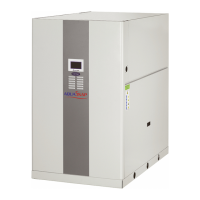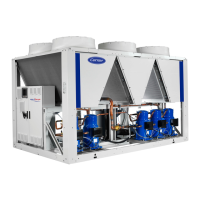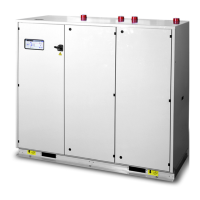48
Typical water piping diagram, units with hydraulic modules
2
6
15
10
9
8
5
1
3
4
7
6
14
9
8
5
1
2
4
PT
PT
TT
TT
PT
PT TT
13
16
TT
3
7
10
12
6
6
Unit water inlet
Condenser water loop (61WG/30WG)
Unit water outlet
Unit water inlet
Unit water outlet
Evaporator water loop (61WG/30WG/30WGA)
Components of unit and hydraulic module
1 Victaulic screen lter (option 293 or 293A only)
2 Expansion tank (option 293 or 293A only)
3 Safety valve (option 293 or 293A only)
4 Water pump
5 Air vent
6 Water drain valve
7/8 Entering/leaving pressure sensor
9/10 Entering/leaving temperature probe
12 Flow switch 61WG option 272 (sizes 020-045 only)
13 Compressor
14 Evaporator
15 Condenser
16 Expansion device
NOTE: Units without hydraulic module include a ow switch.
9.3 - Frost protection
The units are designed to be installed under cover at outside
temperatures between +5 °C and +40 °C. Therefore they do not
include anti-freeze protection, as standard.
If the water piping is in an area where the ambient tempera-ture
can fall below 0 °C it is recommended to install a trace heater on
the piping and to add an antifreeze solution to protect the unit and
the water piping to a temperature of 10 K below the lowest
temperature likely to be reached at the installation site.
Use only antifreeze solutions, approved for heat exchanger duty.
If the system is not protected by an antifreeze solution and will
not be used during the freezing weather conditions, draining of
the cooler and outdoor piping is mandatory. Damage due to
freezing is not covered by the warranty.
IMPORTANT: Depending on the climatic conditions in your
area you must:
- Add ethylene glycol with an adequate concentration to
protect the installation up to a temperature of 10 K below
the lowest temperature likely to occur at the installation site.
- If the unitis not usedfor an extendedperiod, it is
recommended to drain it, and as a safety precaution add
ethylene glycolto theheat exchanger, using the heat
exchangerwaterenteringpurgevalveconnection.
- Atthestartofthenextseason,relltheunitwithwater
and add an inhibitor.
- Fortheinstallationofauxiliaryequipment,theinstaller
must comply with basic regulations, especially for
minimum and maximum flow rates, whichmust be
between the values listed in the operating limit table
(chapter5-“Applicationdata”).
To avoid corrosion by differential aeration, the complete heat
exchange circuit must be charged with nitrogen, if it is drained for
longer than one month. If the heat exchange uid does not comply
with the manufacturer recommendations, the circuit must
immediately be lled with nitrogen.
9.4 - Flow switch (units without hydraulic module)
IMPORTANT:theunitwaterowswitchmustbeenergised,
and the chilled water pump interlock must be connected.
Failure to follow this instruction will void the manufacturer’s
guarantee.
The ow switch is supplied, installed on the evaporator leaving
water pipe and preset at the factory to cut out when there is
insufcient water ow.
Terminals 34 and 35 are provided for eld installation of the chilled
water pump interlock (auxiliary contact for pump operation to be
wired on site).
9 - WATER CONNECTIONS

